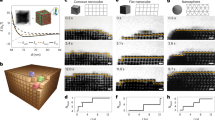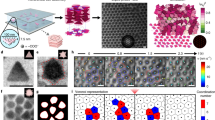Abstract
Microstructure plays an essential role in determining the properties of crystalline materials1. A widely used method to influence microstructure is the addition of nucleating agents1. Observations on films formed from clay–polymer blends indicate that particulate additives, in addition to serving as nucleating agents, may also perturb crystal growth, leading to the formation of irregular dendritic morphologies2,3. Here we describe the formation of these 'dizzy dendrites' using a phase-field theory, in which randomly distributed foreign particle inclusions perturb the crystallization by deflecting the tips of the growing dendrite arms. This mechanism of crystallization, which is verified experimentally, leads to a polycrystalline structure dependent on particle configuration and orientation. Using computer simulations we demonstrate that additives of controlled crystal orientation should allow for a substantial manipulation of the crystallization morphology.
This is a preview of subscription content, access via your institution
Access options
Subscribe to this journal
Receive 12 print issues and online access
$259.00 per year
only $21.58 per issue
Buy this article
- Purchase on Springer Link
- Instant access to full article PDF
Prices may be subject to local taxes which are calculated during checkout






Similar content being viewed by others
References
Cahn, R.W. The Coming of Materials Science (Pergamon, Oxford, 2001).
Ferreiro, V., Douglas, J.F., Warren, J.A. & Karim, A. Nonequilibrium pattern formation in the crystallization of polymer blend films. Phys. Rev. E 65, 042802 (2002).
Ferreiro, V., Douglas, J.F., Warren, J.A. & Karim, A. Growth pulsations in symmetric dendritic crystallization in polymer blend films. Phys. Rev. E 65, 051606 (2002).
Keith, H.D. & Padden, F.J. Crystallization of polymers from the melt and the structure of bulk semicrystalline polymers. J. Appl. Phys. 34, 2409–2421 (1963).
Gránásy, L., Börzsönyi, T. & Pusztai, T. Nucleation and bulk crystallization in binary phase field theory. Phys. Rev. Lett. 88, 206105 (2002).
Gránásy, L., Börzsönyi, T. & Pusztai, T. Crystal nucleation and growth in binary phase field theory. J. Cryst. Growth 237–239, 1813–1817 (2002).
Warren, J.A. & Boettinger, W.J. Prediction of dendritic growth and microsegregation patterns in a binary alloy using the phase-field method. Acta Metall. Mater. 43, 689–703 (1995).
Kobayashi, R., Warren, J.A. & Carter, W.C. Vector-valued phase field model for crystallization and grain boundary formation. Physica D 119, 415–423 (1998).
Kobayashi, R., Warren, J.A. & Carter, W.C. Modeling grain boundaries using a phase-field technique. Physica D 140, 141–150 (2000).
Huisman, W.J. et al. Layering of a liquid metal in contact with a hard wall. Nature 390, 379–381 (1997).
Davidchack, R.L & Laird, B.B. Simulation of the hard-sphere crystal-melt interface. J. Chem. Phys. 108, 9452–9462 (1998).
Hoyt, J.J., Asta, M. & Karma, A. Method for computing the anisotropy of the solid-liquid interfacial free energy. Phys. Rev. Lett. 86, 5530–5533 (2001).
Stefanescu, D.M., Moitra, A., Kacar, A.S. & Dhindaw, B.K. The influence of buoyant forces and volume fraction of particles on the particle pushing/entrapment transition during directional solidification of Al/SiC and Al/graphite composites. Metall. Trans. A 29, 231–239 (1990).
Magill, J.H. Spherulites: A personal perspective. J. Mater. Sci. 36, 3143–3164 (2001).
Eggleston, J.J., McFadden, G.B. & Voorhees, P.W. A phase-field model for highly anisotropic interfacial energy. Physica D 150, 91–103 (2001).
Allen, L., Beijersbergen, M.W., Spreeuw R.J.C. & Woerdman, J.P. Orbital angular-momentum of light and the transformation of Laguerre-Gaussian laser modes. Phys. Rev. A 45, 8185–8189 (1992).
Sekhar, J.A. & Trivedi, R. Solidification microstructure evolution in the presence of inert particles. Mater. Sci. Eng. A 147, 9–21(1991).
Rohatgi, P.K., Pasciak, K., Narendranath, C.S., Ray, S. & Sachdev, A. Evolution of microstructure and local thermal conditions during directional solidification of A356-SiC particle composites. J. Mater. Sci. 29, 5357–5366 (1994).
Dutta, B. & Surappa, M.K. Directional dendritic solidification of a composite slurry: Part I. Dendrite morphology. Metall. Mater. Trans. A 29, 1319–1327 (1998).
Dutta, B. & Surappa, M.K. Directional dendritic solidification of a composite slurry: Part II. Particle distribution. Metall. Mater. Trans. A 29, 1329–1339 (1998).
Acknowledgements
This work has been supported by contracts OTKA-T-037323, ESA Prodex 14613/00/NL/SFe, and ESA MAP Project No. AO-99-101. The authors would like to thank W. J. Boettinger for his helpful comments and criticism.
Author information
Authors and Affiliations
Corresponding author
Ethics declarations
Competing interests
The authors declare no competing financial interests.
Rights and permissions
About this article
Cite this article
Gránásy, L., Pusztai, T., Warren, J. et al. Growth of 'dizzy dendrites' in a random field of foreign particles. Nature Mater 2, 92–96 (2003). https://doi.org/10.1038/nmat815
Received:
Accepted:
Published:
Issue Date:
DOI: https://doi.org/10.1038/nmat815
This article is cited by
-
Fast crystal growth at ultra-low temperatures
Nature Materials (2021)
-
Y2O3–Al2O3 microsphere crystallization analyzed by electron backscatter diffraction (EBSD)
Scientific Reports (2020)
-
Combined Effects of Ultrasonic Melt Treatment and Cu/Mg Solute on the Microstructure and Mechanical Properties of a Hypoeutectic Al-7Si Alloy
Metallurgical and Materials Transactions A (2019)
-
Dendritic Morphologies of Hot-Dip Galvanized Zn-0.2 Wt Pct Al Coatings on Steel Sheets
Metallurgical and Materials Transactions A (2019)
-
Influence of Ir Additions and Icosahedral Short Range Order (ISRO) on Nucleation and Growth Kinetics in Au-20.5Wt Pct Cu-4.5Wt PctAg Alloy
Metallurgical and Materials Transactions A (2019)



